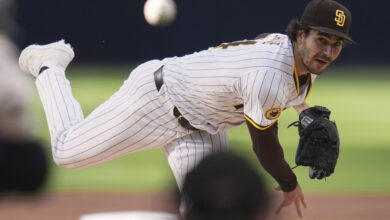
David Ross Indicates Cubs Need at Least 2 More Starters for Next Year
Alec Mills 'Made a Pretty Strong Case'
Trading your ace during the winter is a pretty good sign that you’re not going to have an elite rotation. And while Yu Darvish has struggled with the Padres since the start of July, Zach Davies — who many reasoned somewhat convincingly was a solid option in return — has toiled through a career-worst season. Same for Kyle Hendricks, who may need to see a chiropractor for whiplash after allowing 31 home runs in as many games.
After years of begging the organization to be aggressive with pitching development by throwing prospects into the mix sooner, the Cubs have used rookies Justin Steele and Keegan Thompson as starters after first cutting their teeth in relief roles. The results have been mixed, which is pretty much what you’d expect from rookies who didn’t really have a 2020 season.
Adbert Alzolay falls just outside that group because he’d made six MLB starts prior to opening this season in the rotation and racking up 21 starts. And he really is a first-year pitcher when you consider that his two favorite offerings, the slider and sinker, were only added to his repertoire in 2020.
The Cubs certainly have a lot of options as we look ahead to next year, they just don’t have many sure things. You could argue they don’t have any if you’re of the mind that they’ll look to trade Hendricks during the offseason, but he doesn’t feel like a good bet to be moved. Not to me, anyway.
So what is David Ross thinking when it comes to a 2022 season that is still too far away to think about even though we’d rather not think more about this season?
“I would definitely pen in Kyle Hendricks,” Ross told the media on Wednesday. “I think Alec Mills has made a pretty strong case for a guy that you can count on and a reliable starter.”
Ah yes, I forgot about Mills because the Cubs always seem to do the same. I had to be reminded of the fact that all 11 of his appearances last year were starts because he’s otherwise been used as a swingman who ends up joining the rotation when someone else washes out or gets hurt.
Mills has probably been the Cubs’ most consistent starter this season, not that the bar has been set very high there, and he could be a steadying force at the back end. From the sounds of it, though, the Cubs aren’t just going to run it back with the young guys to fill out the rest.
“Maybe one of those three guys can fit in there somewhere,” Ross added. “The experience they’ve gained this year, and having an offseason to work on things, and coming in and making an impression will be a nice thing we’ll have going into next year’s spring training.”
You don’t need to read between the lines to figure out that the Cubs are going to be targeting two starters this offseason, whether it’s via trade or free agency. Opinions differ on whether or not Jed Hoyer will have the budget to address those needs with anything other than veterans looking for pillow deals, but the Cubs could add around $100 million in salary this winter while still remaining at or below their 2021 payroll figure.
That kind of green could get a big name or two to jump the fence, perhaps in a manner similar to Jon Lester‘s arrival in 2015. What might it mean to a rebuilding organization to lure Max Scherzer into the fold? A lot of you may want to point to his age, understandably so, but at 37 years old he’s still the best pitcher on a staff that features Clayton Kershaw and Walker Buehler.
What’s more, Scherzer isn’t going to be seeking a 10-year deal at his age and could essentially serve as the pace car for a team looking to get back up to full speed. There are some other options from among a pool of big-time performers who might cost less per season and more overall due to age, like Kevin Gausman. He’s figured things out in San Francisco and is more than making good on his qualifying offer this season.
Should the Cubs be able to lock down an upper-tier starter, they can go shopping for someone else with a little more risk/reward factor. I won’t rattle off a bunch of names here, though you can rest assured we’ll be looking at them more closely when the time comes.
The point is that adding two locks to the rotation gives you three for-sure starters with Mills and the three younger pitchers battling for the final spots. It also means filling out a bullpen that already looks to be coming together nicely with a collection of young, controlled arms that could be around for years. At the risk of over-simplifying things, the math on this really is pretty easy.
I’m not necessarily saying it’s probable, mind you, only that it’s very possible for the Cubs to upgrade the rotation in a very big way while still leaving plenty of money to improve the roster elsewhere. And they could do it all at a lower cost than what they were at this season. So even if you’re very firmly in the “Ricketts is cheap” camp, you should be able to see the logic in what’s being presented.
Of course, that assumes the Cubs truly do tend to start competing again next year. Based on the amount of green in the stands, which means way less green in the coffers, they can’t afford to punt another season.

